
Refer to PSP 7th Perihelion Campaign page.
2021-01-08 (CSV, PDF table of coordinates)
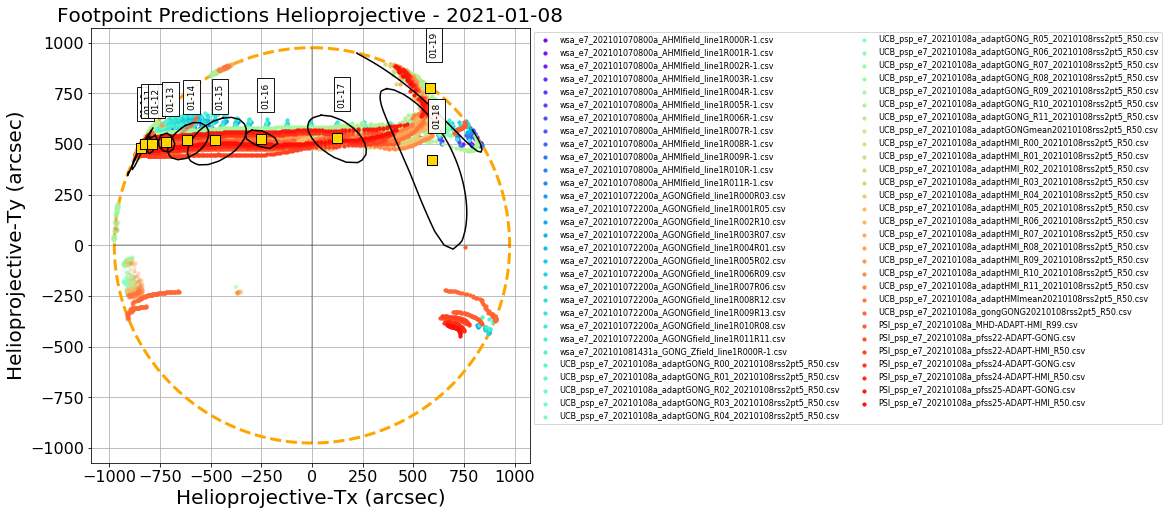
Figure 1.

Figure 2.
Figures above show one footpoint per day plotted on the solar disk and in Carrington coordinates (click on figure to zoom and see caption).
The predicted footpoints were kindly provided by the PSP 7th Perihelion modeling team.
Initial predictions of the footpoint location for the next PSP encounter suggest PSP will largely be connected to a large extension of the northern polar coronal hole. Today until approximately 01/15 PSP will track westwards along the extension, at which points its motion will reverse and will trace the extension eastwards. Around perihelion (01/17), models currently suggest PSP will approach the HCS but most likely will remain above it, at least prior to the footpoints going behind the limb. The coronal hole extension is currently just beyond the east limb as viewed from Earth and should become visible in the next two days. Therefore we advise observers to focus on the east limb at around 30 degrees Heliographic latitude and to track the lower boundary of the extension as it moves across the disk.
2021-01-09 (CSV, PDF table of coordinates)
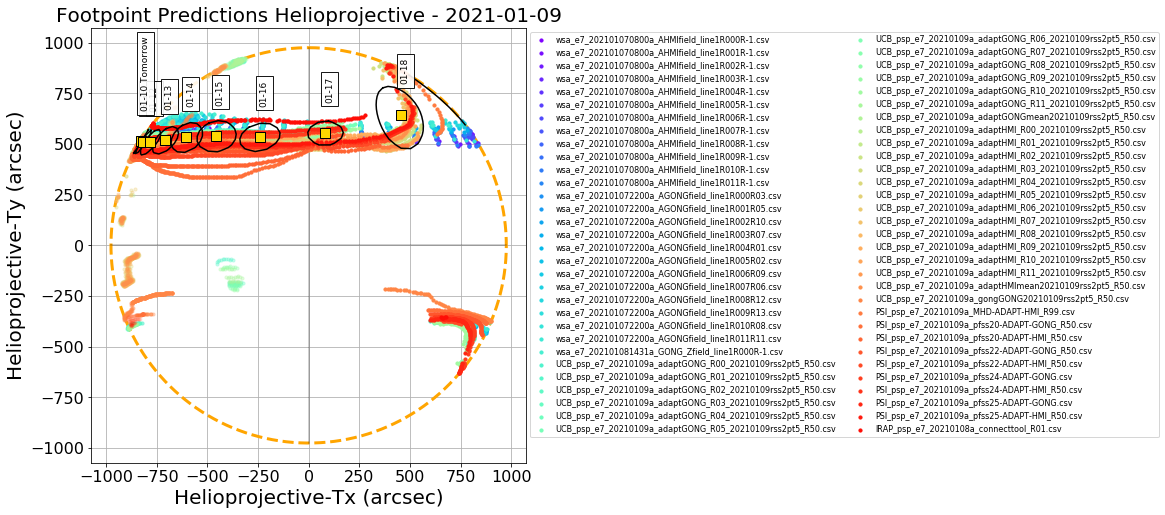
Figure 1.

Figure 2.
Figures above show one footpoint per day plotted on the solar disk and in Carrington coordinates (click on figure to zoom and see caption).
The predicted footpoints were kindly provided by the PSP 7th Perihelion modeling team.
Today's update continues to point to a large northern polar coronal extension as the primary source of solar wind at PSP today through at least the 17th of January. Further, the consensus footpoint for today is almost exactly at the east limb and therefore should now be visible from Earth and continue to migrate onto the disk. The predicted source remains stable and largely model independent through the next 7 days. The predictions for the 18th, 19th and 20th of January begin to diverge somewhat with a range of northern and southern hemisphere locations possible, we will continue to monitor and update this and provide multiple targets if necessary. There are currently no active regions on the Earthward facing solar disk or from the STEREO A perspective. As such, observers are advised to focus on the consensus prediction above.
2021-01-10 (CSV, PDF table of coordinates)
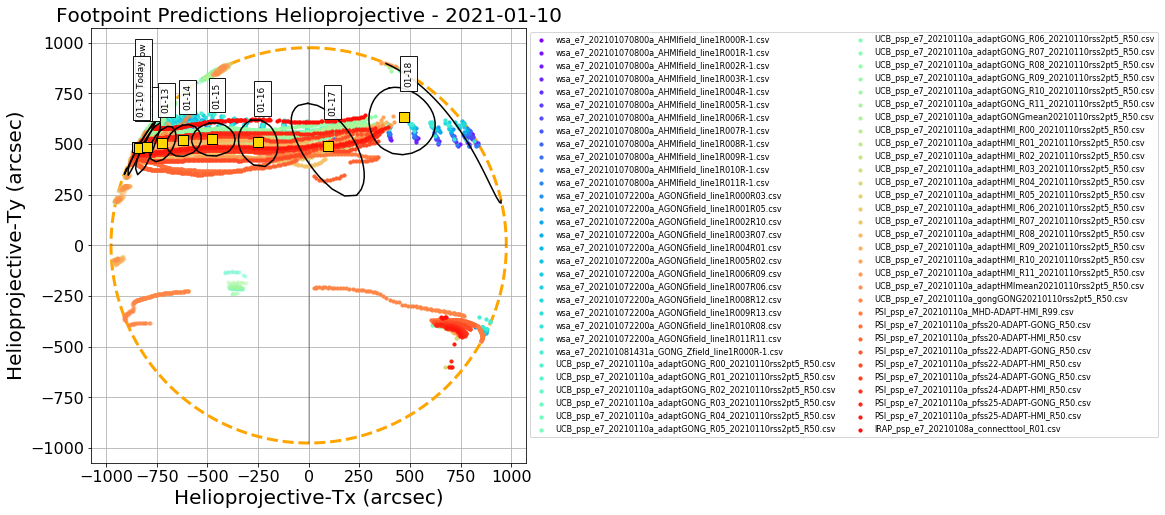
Figure 1.

Figure 2.
Figures above show one footpoint per day plotted on the solar disk and in Carrington coordinates (click on figure to zoom and see caption).
The predicted footpoints were kindly provided by the PSP 7th Perihelion modeling team.
Prediction update 2021/1/10 As yesterday, footpoint predictions continue to suggest the solar wind source for PSP will continue to be the lower edge of the northern polar coronal hole extension currently located at the East limb around 30 degrees heliographic latitude. The footpoint will track this feature across the disk until at least January 17th. We continue to monitor predictions beyond this date which currently remain uncertain with footpoint predictions in both hemispheres and in many cases not corresponding to clear structure in the EUV image. Migration of the footpoints beyond the west limb appears to remain consistent with ballistic estimates and will likely occur on or before January 20th. There are currently no active regions on the Earthward facing solar disk or from the STEREO-A perspective. As such, observers are advised to focus on the consensus prediction above.
2021-01-11 (CSV, PDF table of coordinates)
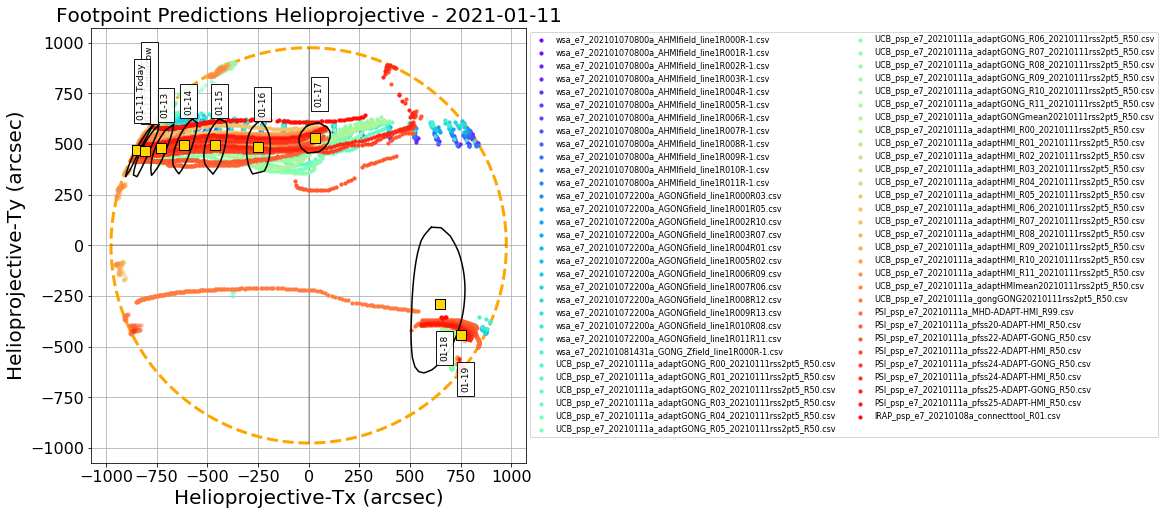
Figure 1.

Figure 2.
Figures above show one footpoint per day plotted on the solar disk and in Carrington coordinates (click on figure to zoom and see caption).
The predicted footpoints were kindly provided by the PSP 7th Perihelion modeling team.
Prediction update 2021/1/11 Footpoint predictions continue to point to the lower edge of the northern polar coronal hole extension currently at the East limb and rotating on disk around 30 degrees heliographic latitude through January 17th. After this, the majority of predictions suggest a brief dip below the heliosphere current sheet and connection to the very tip of the prominent southern polar coronal hole extension around 90 degrees longitude for the 18th and 19th of January. Then PSP's solar wind source is likely to return to the Northern polar coronal hole but may already be behind the limb at this point. There are currently no active regions on the Earthward facing solar disk or from the STEREO-A perspective. As such, observers are advised to focus on the consensus prediction above.
2021-01-12 (CSV, PDF table of coordinates)
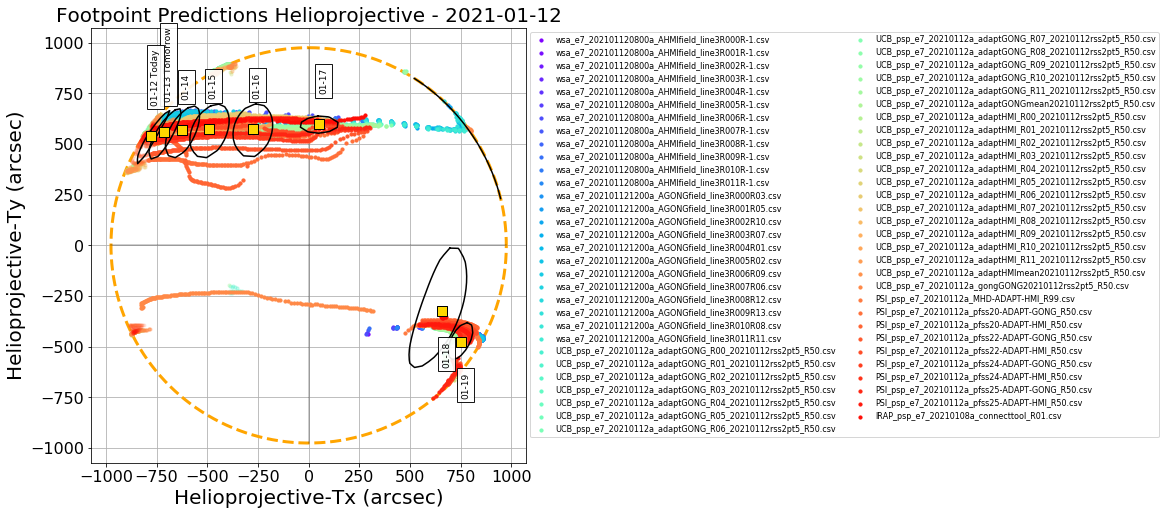
Figure 1.

Figure 2.
Figures above show one footpoint per day plotted on the solar disk and in Carrington coordinates (click on figure to zoom and see caption).
The predicted footpoints were kindly provided by the PSP 7th Perihelion modeling team.
Prediction update 2021/1/12 Footpoint predictions continue to point to the lower edge of the northern polar coronal hole extension currently near the East limb around 30 degrees heliographic latitude and will continue to move across the disk at a near constant latitude through January 17th. After this, the consensus prediction suggests a brief dip below the heliospheric current sheet and connection to the very tip of the prominent southern polar coronal hole extension around 90 degrees longitude for the 18th and 19th of January, although some ensemble members indicate the possibility of remaining north of the HCS. After the 19th the source tends to converge again to the Northern polar coronal hole but may already be behind the limb at this point. There are currently no active regions on the Earthward facing solar disk or from the STEREO-A perspective. As such, observers are advised to focus on the consensus prediction above.
2021-01-13 (CSV, PDF table of coordinates)
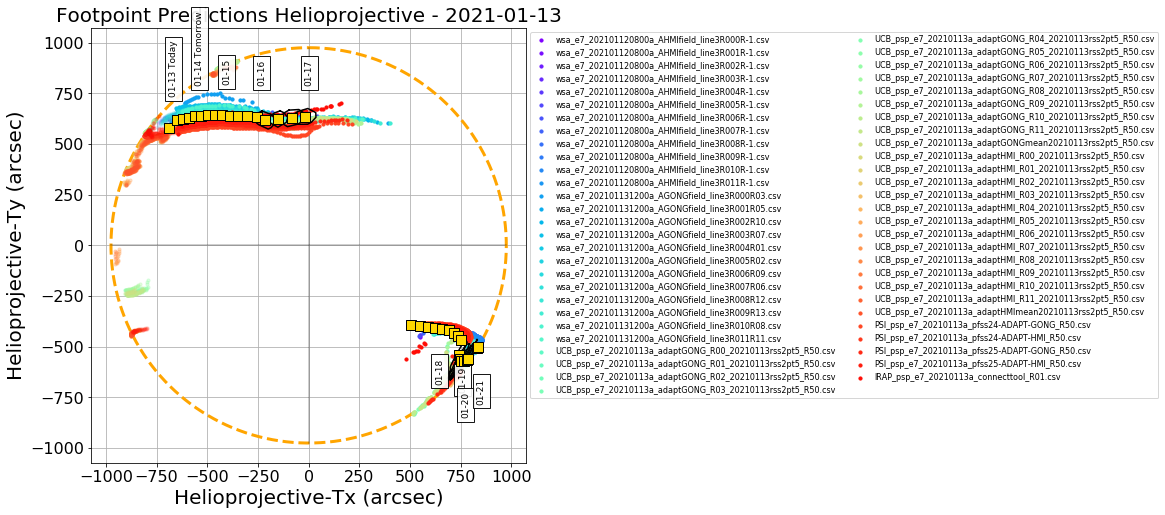
Figure 1.

Figure 2.
Figures above show one footpoint per day plotted on the solar disk and in Carrington coordinates (click on figure to zoom and see caption).
The predicted footpoints were kindly provided by the PSP 7th Perihelion modeling team.
Prediction update 2021/1/13 Today we have increased the temporal cadence of our consensus prediction to every 6 hours to reflect the acceleration of PSP's trajectory across the solar disk. As such, please note this difference reflected in the timestamps in today's consensus CSV file.The prediction outlook is becoming clearer for the remaining duration of the on disk phase. We predict that PSP will remain connected to the tip of the Northern polar coronal hole extension and will continue to corotate with it until Jan 17th. The consensus prediction then suggests PSP will cross the heliospheric current sheet between 00:00 and 06:00 UT on January 17th and will then connect to the tip of the southern polar coronal hole extension around 102 degrees Carrington longitude and will continue to rotate with this source which will rotate off the west limb between 06:00 and 12:00 UT on January 21. There are currently no active regions on the Earthward facing solar disk or from the STEREO-A perspective. As such, observers are advised to focus on the consensus prediction above.
2021-01-14 (CSV, PDF table of coordinates)
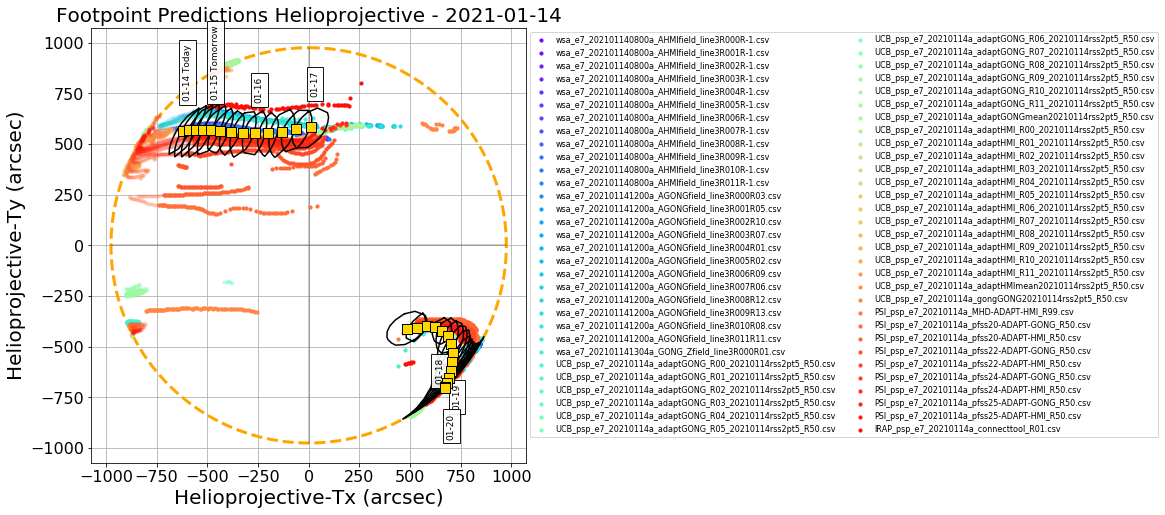
Figure 1.

Figure 2.
Figures above show one footpoint per day plotted on the solar disk and in Carrington coordinates (click on figure to zoom and see caption).
The predicted footpoints were kindly provided by the PSP 7th Perihelion modeling team.
Prediction update 2021/1/14 The prediction outlook remains stable from yesterday and for the remaining duration of the on disk phase. We predict that PSP will remain connected to the tip of the Northern polar coronal hole extension and will continue to corotate with it until Jan 17th. The consensus prediction then continues to suggests PSP will cross the heliospheric current sheet between 00:00 and 06:00 UT on January 17th, although some ensemble members predict the HCS crossing as late at 12UT on January 18th so observers may wish to continue to target the northern coronal hole extension through this time as a secondary target. After crossing the HCS PSP will connect to the southern polar coronal hole extension around 102 degrees longitude. Due to PSP's super rotation with respect to the photosphere, our consensus target shows PSP's footpoints will migrate down to lower latitudes along the east edge of the coronal hole extension and rotate off the west limb between 00:00 and 06:00 UT on January 21. There are currently no active regions or sunspots on the Earthward facing solar disk. As such, observers are advised to focus on the consensus predictions above.
2021-01-15 (CSV, PDF table of coordinates)
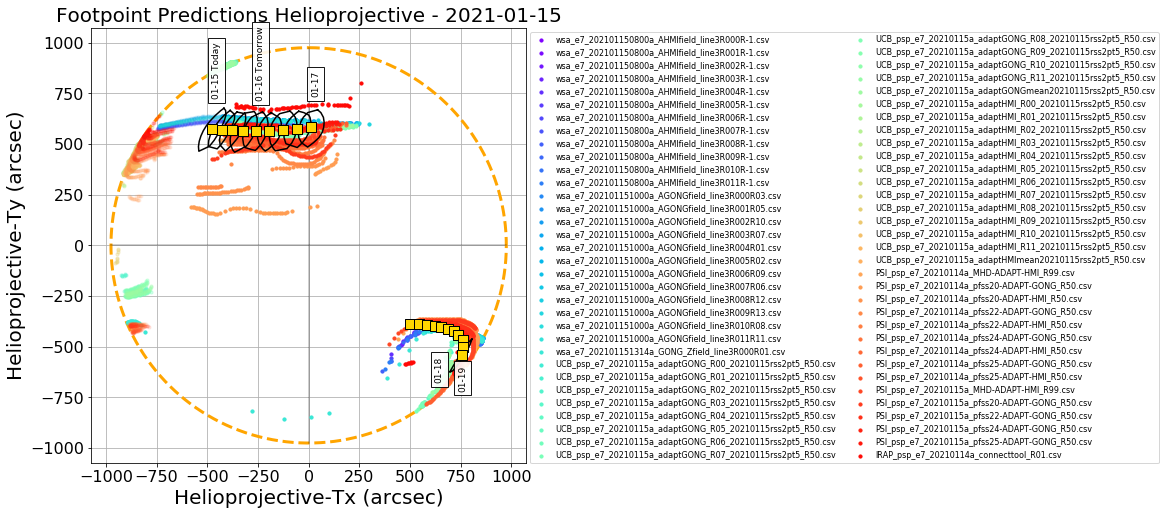
Figure 1.

Figure 2.
Figures above show one footpoint per day plotted on the solar disk and in Carrington coordinates (click on figure to zoom and see caption).
The predicted footpoints were kindly provided by the PSP 7th Perihelion modeling team.
Prediction update 2021/1/15 PSP has just passed through corotation and is now accelerating into perihelion and will start to move faster than the corotating sources it will connect to. The prediction outlook mostly remains stable from yesterday for the remaining duration of the on disk phase. We predict that PSP will remain connected to the tip of the Northern polar coronal hole extension and will continue to corotate with it until Jan 17th. The consensus prediction then continues to suggest PSP will cross the heliospheric current sheet between 00:00 and 06:00 UT on January 17th. Some ensemble members still predict the HCS crossing as late at 12UT on January 18th so observers may wish to continue to target the northern coronal hole extension through this time as a secondary target. After crossing the HCS PSP will connect to the southern polar coronal hole extension around 102 degrees longitude. Due to PSP's super rotation with respect to the photosphere, our consensus target shows PSP's footpoints will initially migrate down to lower latitudes along the east edge of the coronal hole extension. However, in a change from yesterday, the consensus now points to a further crossing of the HCS back to the Northern polar coronal hole by midnight UT on 2021-01-20 and the resulting jump in Carrington longitude of the footpoint will drive the footpoint behind the West limb. There are currently no active regions or sunspots on the Earthward facing solar disk. As such, observers are advised to focus on the consensus predictions above.
2021-01-16 (CSV, PDF table of coordinates)
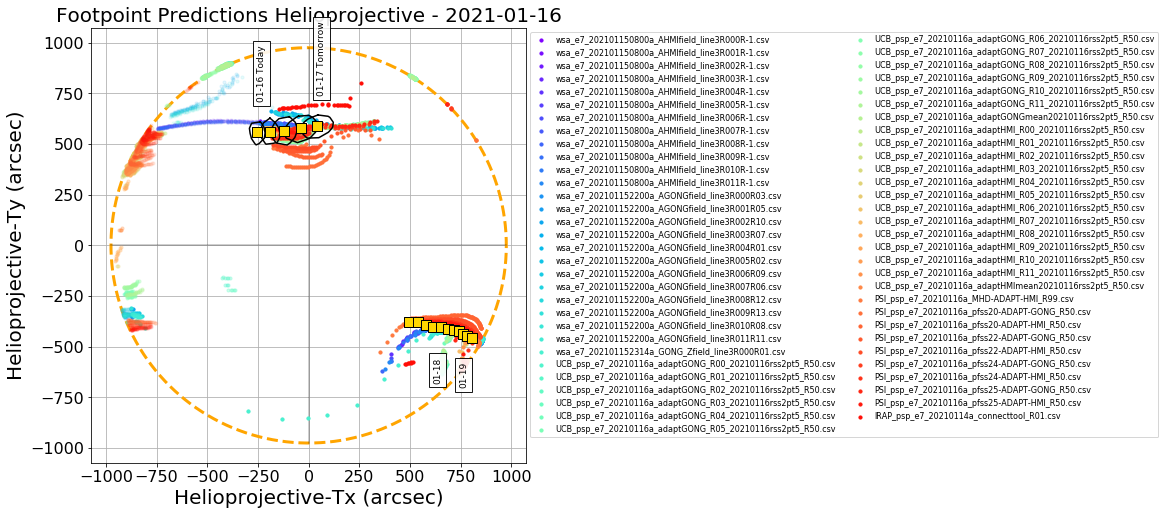
Figure 1.

Figure 2.
Figures above show one footpoint per day plotted on the solar disk and in Carrington coordinates (click on figure to zoom and see caption).
The predicted footpoints were kindly provided by the PSP 7th Perihelion modeling team.
Prediction update 2021/1/16 The prediction outlook remains stable from yesterday for the remaining duration of the on-disk phase as PSP's footpoint passes through the central meridian today. We predict that PSP will remain connected to the same Northern polar coronal hole extension until (UT) tomorrow, Jan 17th. The consensus prediction then continues to suggest PSP will cross the heliospheric current sheet between 00:00 and 06:00 UT on January 17th. Some ensemble members still predict the HCS crossing as late as 12UT on January 18th so observers may wish to continue to target the northern coronal hole extension through this time as a secondary target. After crossing the HCS, PSP will connect to the southern polar coronal hole extension around 102 degrees longitude. Due to PSP's super-rotation with respect to the photosphere, our consensus target shows PSP's footpoints will initially migrate down to lower latitudes along the east edge of the coronal hole extension. The consensus points to a further crossing of the HCS back to the Northern polar coronal hole between 18:00 - 23:59 UT on 2021-01-19 (Tuesday), slightly earlier than yesterday's prediction. The resulting jump in Carrington longitude of the footpoint will drive the footpoint behind the West limb meaning the predicted source will no longer be visible from Earth. An active region has emerged on the solar disc (NOAA number 12796), however the probability of this active region producing a flare or transient event over the next 24 hour remains very small. As such, observers are still advised to focus on the above consensus prediction.
2021-01-17 (CSV, PDF table of coordinates)
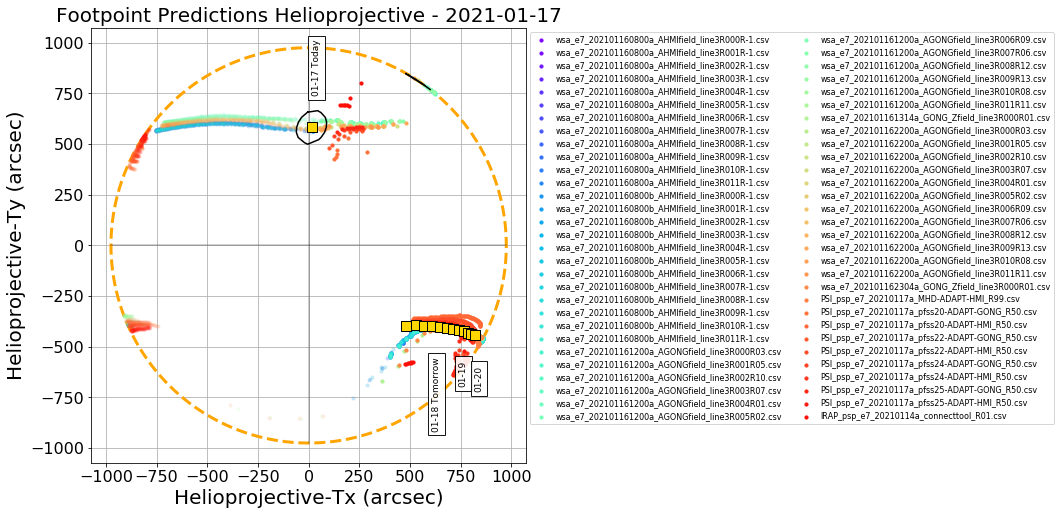
Figure 1.
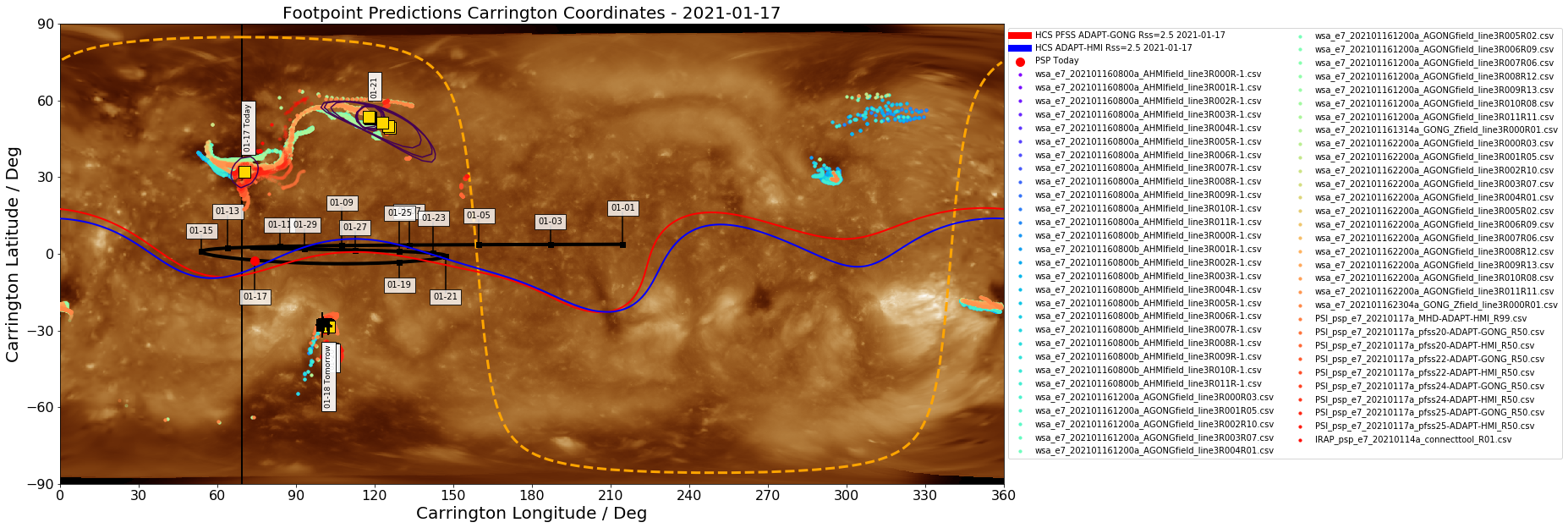
Figure 2.
Figures above show one footpoint per day plotted on the solar disk and in Carrington coordinates (click on figure to zoom and see caption).
The predicted footpoints were kindly provided by the PSP 7th Perihelion modeling team.
Prediction update 2021/1/17 As PSP goes through perihelion today, the consensus prediction suggests a HCS crossing 00:00 and 06:00 UT (i.e. this will already have occurred at the time of posting of this prediction). Some ensemble members continue to predict the HCS crossing as late as 12UT on January 18th (tomorrow) so observers may wish to continue to target the northern coronal hole extension through this time as a secondary target. PSP will now briefly connect to the very tip of the southern polar coronal hole extension around 100 degrees longitude. The latitude of the footpoint remains stable at around -27 degrees latitude and is predicted to persist until 00:00UT on the 20th January (Wednesday). After this, a further HCS crossing from South to North and the resulting jump in Carrington longitude of the footpoint will drive the footpoint behind the West limb. However, some ensemble members predict this latter HCS crossing to occur up to 24 hours later (00:00UT Jan 21st), and therefore observers may wish to continue to target the southern polar coronal hole extension through this time. The NOAA 12796 active region persists in the southern hemisphere, but shows signs of decay. Current forecasting models continue to suggest a low probability of AR 12796 producing a flare or transient event. As such, observers are still advised to focus on the above consensus prediction.
2021-01-18 (CSV, PDF table of coordinates)
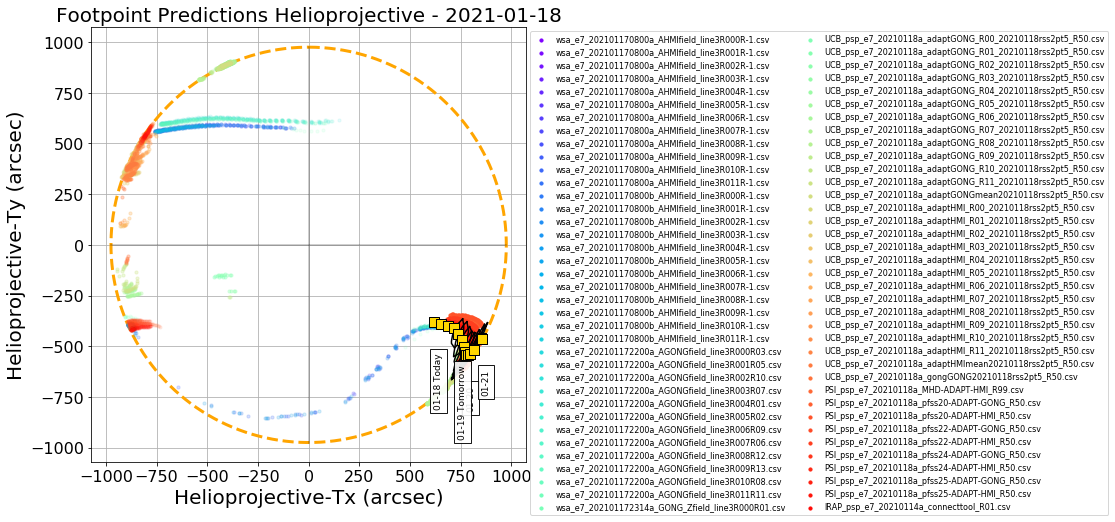
Figure 1.
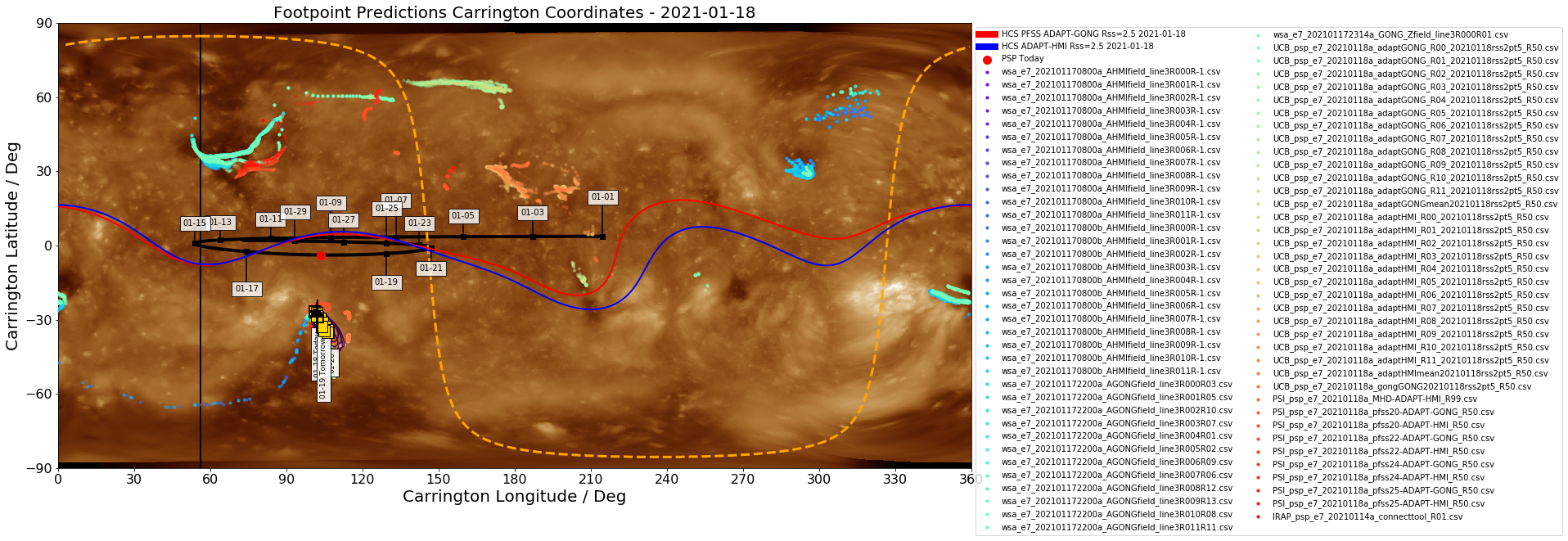
Figure 2.
Figures above show one footpoint per day plotted on the solar disk and in Carrington coordinates (click on figure to zoom and see caption).
The predicted footpoints were kindly provided by the PSP 7th Perihelion modeling team.
Prediction update 2021/1/18 In today's update the consensus prediction now shows PSP connecting to the southern polar coronal hole extension around 102 degrees Carrington Longitude. The main changeable factor in our day-to-day predictions is whether PSP will follow this feature as it rotates off the limb or if it will cross the HCS prior to this. Today's update points to the former scenario with PSP tracking down the edge of the extension and following it off the West limb by end of day, January 21st. Therefore we advise observers to continue to target this coronal hole extension until it rotates off the limb. NOAA active region 12796 has continued to decay and is not likely to produce any flares or transient events. Another active region (NOAA 12797) has rotated into view from behind the East limb, however this active region is also not expected to produce any transient events. As such, observers are still advised to focus on the above consensus prediction.
2021-01-19 (CSV, PDF table of coordinates)
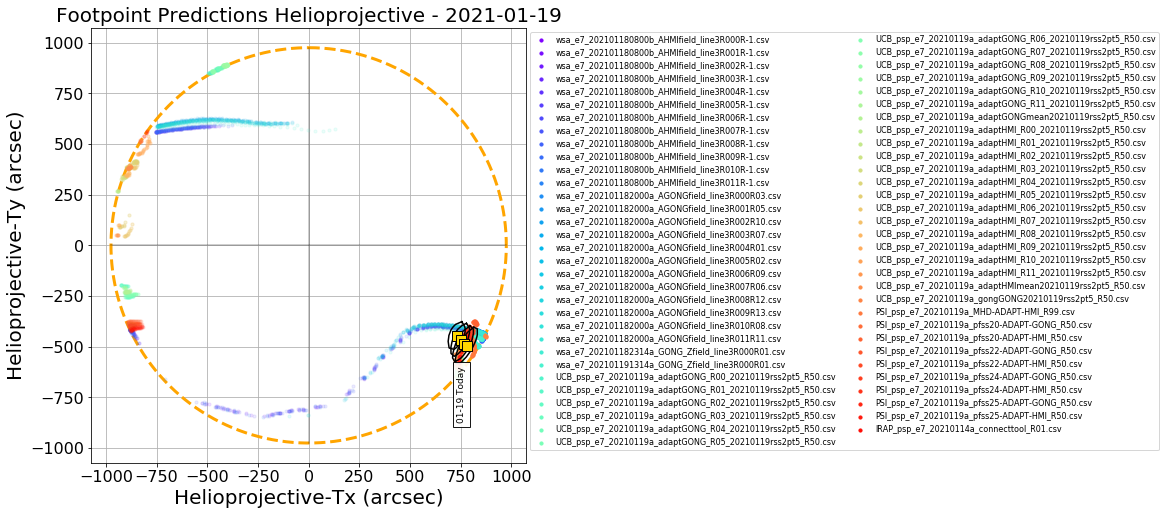
Figure 1.

Figure 2.
Figures above show one footpoint per day plotted on the solar disk and in Carrington coordinates (click on figure to zoom and see caption).
The predicted footpoints were kindly provided by the PSP 7th Perihelion modeling team.
Prediction update 2021/1/19 In today's penultimate update the consensus prediction continues to point towards the southern polar coronal hole extension at around 100 degrees Carrington longitude, which is now located very close to the West limb. As yesterday, the timing of a subsequent HCS crossing and limb passage remains uncertain. The consensus today suggests this will happen by the end of today UT (01/19) but some ensemble members continue to point to an up to 24 hour uncertainty. Therefore, we continue to advise observers to target the southern polar coronal hole extension near the west limb through end of day UT tomorrow (01/20). In tomorrow's final update we expect to confirm limb passage of the PSP footpoint. NOAA active region 12796 has completely decayed, while NOAA AR 12797 has remained on the solar disk but has a small likelihood of producing a flare within the next 24 hours (22% change of producing a C-class flare as estimated by MCSTAT). As such, observers are still advised to focus on the above consensus prediction.
2021-01-20 (CSV, PDF table of coordinates)
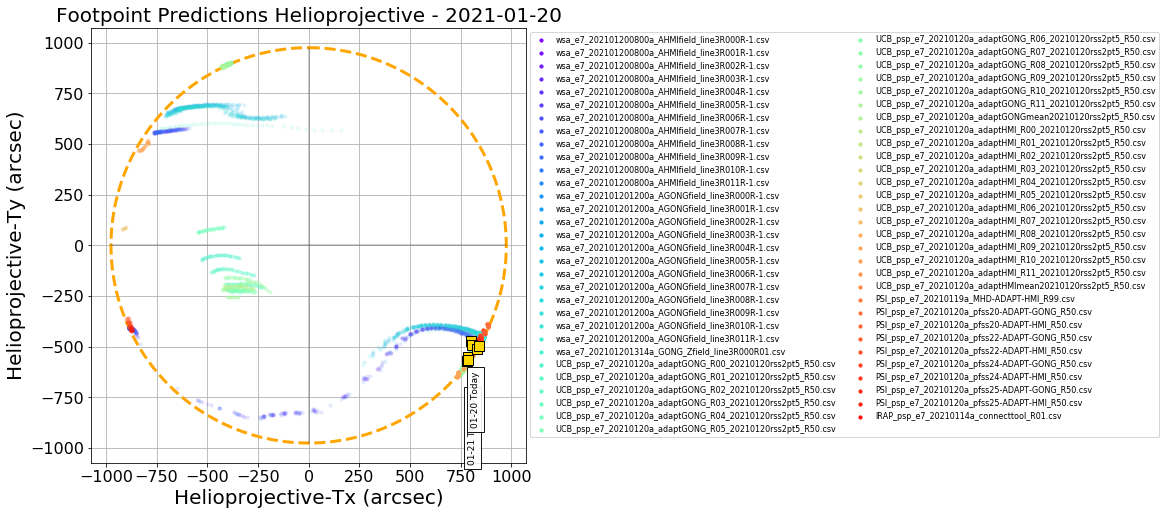
Figure 1.

Figure 2.
Figures above show one footpoint per day plotted on the solar disk and in Carrington coordinates (click on figure to zoom and see caption).
The predicted footpoints were kindly provided by the PSP 7th Perihelion modeling team.
Prediction update 2021/1/20 In today's final update the consensus prediction continues to point towards the southern polar coronal hole extension at around 100 degrees Carrington longitude, very close to the West limb. The consensus today shows signs of convergence that PSP will simply remain below the HCS connecting to this same source as it corotates behind the West limb. The location PSP is connecting to is expected to rotate beyond the limb between 12:00 and 18:00 UT tomorrow 01/21. Thus, observers should continue to target this location on the West limb at about -32 degrees solar latitude through this time. After this time, the PSP solar wind sources will no longer be visible from Earth. NOAA active region 12797 has remained unchanged from yesterday and is classified as a beta/C-type sunspot group. It is possible that the AR may produce C-class activity in the next 24 hours (22% chance of C-class activity from MCSTAT).
Time, consensus carrington longitude (deg), latitude (deg), error in longitude, error in latitude, helioprojective position in X and Y (arcseconds), and Cons-Type which describes the method used to generate the consensus. The consensus is generated by forming a distribution of footpoint predictions from all modelers for each 24 hour period, and attempting to fit a Kent distribution . If the fitting fails (Cons-Type = median), the median in longitude and latitude are quoted. If the fitting is successful (Cons-Type = Kent), the quoted errors are formed by drawing random samples from the fitted distribution and computing the standard deviation in longitude and latitude of those samples. If the fitting fails, the quoted errors are the standard deviation in the longitude and latitude from the raw distribution of predictions. The full shape of the distribution is described by black contours in the associated plots on this website.
**Please note the carrington coordinates (lon,lat) are valid from the quoted timestamp (in UTC) until the next timestamp. The helioprojective coordinates quoted (HP-Tx, HP-Ty) are computed from the carrington coordinate at the quoted timestamp (e.g. midnight UTC each day) and so are valid instantaneously at this time but will corotate with the Sun until the next quoted timestamp.
Individual model prediction tables of coordinates may be found in a Public DropBox. Files in the Public DropBox have three-letter identifiers indicating the associated model (see below).
Three-letter designation for Public DropBox: UCB. Kindly provided by Sam Badman. The model is a simple ballistic propagation from PSP down to the source surface assuming slow wind 360km/s, and then tracing this sub-PSP trajectory through a PFSS model to get footpoints at the photosphere. The source surface height here is 2.5Rs. The PFSS model is generated using various ADAPT maps with GONG and HMI as input, and the model is run using the open source pfsspy package. A more detailed explanation of the model and comparison to PSP E1 results are given here.
Three-letter designation for Public DropBox: PSI. Kindly provided by Pete Riley. For these predictions, PSI is using a combination of modeling approaches, including PFSS solutions, empirically-based polytropic MHD solutions, and a more sophisticated approach that includes the effects of waves and turbulence to heat the corona and the WKB approximation for wave pressures to accelerate the solar wind. Additionally, boundary conditions are derived from both HMI and ADAPT synoptic magnetograms. Together, these allow us to generate a rich set of ensemble realizations from which to make our optimal prediction, as well as pool them with other teams’ forecasts to derive a hyper-ensemble prediction.
Three-letter designation for Public DropBox: WSA. Kindly provided by Shaela Jones. The Wang-Sheeley-Arge (WSA) model is a combined empirical and physics-based model of the corona and solar wind. The coronal portion of the Wang-Sheeley-Arge (WSA) model is comprised of the Potential Field Source Surface (PFSS) and Schatten Current Sheet (SCS) models, where the output of the PFSS model serves as input to the SCS model. The solar wind portion of WSA consists of a simple 1-D kinematic propagation code that takes stream interactions into account in an ad-hoc fashion. It provides predictions of the solar wind speed and interplanetary magnetic field IMF polarity at any specified point in the inner heliosphere. The WSA model can use global maps of the photospheric magnetic flux measurements from a number of sources as its inner boundary condition; here we are using an ensemble of maps from the Air Force Data Assimilative Photospheric Flux Transport (ADAPT) model, based on input GONG magnetograms.
Four-letter designation for Public DropBox: IRAP.
A simple ballistic mapping of PSP position is performed down to the PFSS source surface. A slow wind speed of 300km/s is assumed. A Potential Field Source Surface (PFSS) model is then exploited to find the associated connectivity points at the photosphere. The PFSS model is based on [Wang & Sheeley 1992] using a spherical harmonics method.
White-light observations (Carrington synoptic maps from LASCO C2) are exploited in order to select the best PFSS extrapolations among several magnetograms (currently GONG/mrzqs and GONG/ADAPT), the 12 ADAPT realizations and several source surface heights (2.0, 2.5 and 3.0Rs). The PFSS neutral lines are systematically compared against the streamer belt topology, which gives a good approximation of the shape of the sector boundary structure.
In addition, not only one single connectivity point but instead patches of connectivities are provided by the model. They are representative of the uncertainties from the Parker spiral model (ballistic mapping). We assume a gaussian distribution of points around the PSP projected position at the source surface. Then following the PFSS field lines, these probabilistic points give patches of connectivities at the photosphere.